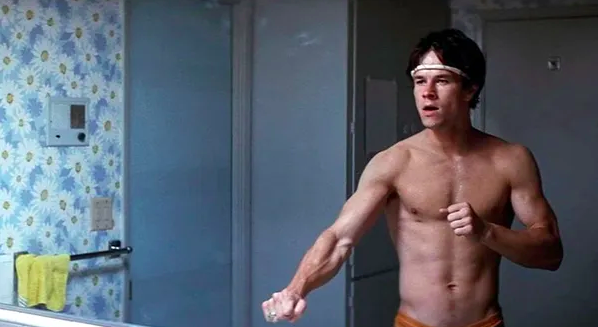By Peter Lehman/The Conversation
If you’ve noticed an uptick of male frontal nudity in TV and in movies in recent years, you’re on to something.
In 1993, I studied patterns of male nudity in my book Running Scared: Masculinity and the Representation of the Male Body. After the old Motion Picture Production Code was replaced by a new ratings system in 1968, frontal male nudity in Hollywood movies in certain contexts was permitted. Drive, He Said, directed by Jack Nicholson in 1971, was an early film to include such a scene, while Richard Gere’s nude scene in 1980’s American Gigolo helped to transform the young actor into an international sex symbol.
Yet female nudity remained far more common in movies, and there was no frontal male nudity on mainstream television as of 1993.
 Euphoria is one of many premium cable TV shows to feature an abundance of prosthetic penises/HBO
Euphoria is one of many premium cable TV shows to feature an abundance of prosthetic penises/HBO
Since then, a lot has changed. Directors and audiences are becoming more and more comfortable showing male nudity.
But nowadays, while we’re much more likely to see penises in mainstream film and television, they’re seldom real. Prosthetic penises – once used for exaggerated effect – have become the norm.
To me, this says something about the unusual significance we continue to grant the penis, along with our cultural need to carefully regulate its representation. In a way, the use of prosthetic penises maintains a certain mystique about masculinity, preserving the power of the phallus.
Skirting The Production Code
There are a number of factors fueling the current wave of frontal male nudity.
In the 1990s, premium cable television channels like HBO became more popular, while streaming platforms like Amazon and Netflix took off in the 21st century.
These channels and platforms aren’t governed by the Motion Picture Association’s ratings system, which strictly limits the circumstances under which the penis can be shown.
According to the ratings – which still regulate theater releases – penises can be shown in nonsexual situations, such as when they appear during a concentration camp scene in Schindler’s List. But if a scene involves sex and frontal male nudity, the actors have to be a certain distance apart. So when Bruce Willis’ penis briefly appeared during an underwater swimming pool lovemaking scene in the The Color of Night, the MPAA objected, citing his proximity to the woman, and the shot had to be cut. Uncensored versions of the film are now available on DVD.
Premium cable TV channels are not governed by these guidelines, and the HBO show Oz, which aired from 1997 to 2003, marked a major turning point. Set in a prison, it was notable for the sheer quantity of full frontal male nudity, with characters shown in a variety of contexts, including showering and in their cells, fully naked.
Another reason for the trend in male nudity has to do with justifiable criticism of the ways women have been sexually objectified on TV and in film. Female nudity has been much more common than male nudity, and most of it tends to involve young, attractive women being showcased in a variety of erotic contexts, with an emphasis on their breasts and buttocks.
Some filmmakers, such as Judd Apatow and Sam Levinson, have said they’ve wanted to level the playing field by featuring more male nudity.
The Proliferation Of The Prosthetic
Like Oz, Starz’ Spartacus, which premiered in 2010, was full of frontal male nudity.
However, there was a key difference: all the penises were prosthetic, which are made to be worn by the actors and look realistic when filmed.
One of the most famous prosthetic penises appeared in Paul Thomas Anderson’s 1997 film Boogie Nights, which is about a porn star played by Mark Wahlberg. At the end of the film, viewers see a close-up shot of the actor’s extremely large prosthetic penis.
 Boogie Nights features one of the most famous prosthetic penises/New Line Cinema
Boogie Nights features one of the most famous prosthetic penises/New Line Cinema
Prosthetics have been used on and off through the years. But after Spartacus their use has became the norm. Now in shows like HBO’s The Deuce and Euphoria, they’re everywhere. Sometimes they’re even digital. In Nymphomaniac: Vols. I and II, director Lars von Trier digitally replaced the actors’ penises with those from body doubles.
Whether they’re tangible or digital they tend to have one thing in common: They’re big.
The Obsession With Size
The prosthetic penis gives filmmakers total control over its representation, and some have used its flexibility to directly address this issue of size.
Take the 2015 romantic comedy The Overnight.
Penis size is first introduced in the opening scene, when a couple has awkward sex due to the husband’s small penis. Later at a dinner party with another couple, penis size becomes the big issue again when a wife swap between the two couples is discussed.
The other man, played by Jason Schwartzman, has an extremely large one, while the man from the opening scene, played by Adam Scott, has a much smaller one, and becomes uncomfortable with the idea of being “exposed.” During a protracted skinny dipping scene, viewers get to see each actor’s prosthetic penis. Within the conventions of the romantic comedy, both couples are united at the end and committed to saving their marriages.
 In The Overnight, penis size is a point of tension, and prosthetics are used to create the contrast/The Orchard
In The Overnight, penis size is a point of tension, and prosthetics are used to create the contrast/The Orchard
The Overnight attempts to deflate the myth that penis size matters. But at the same time that it tackles the obsession with size, it ends up reinforcing the notion – in part because of the opening scene – that bigger is better.
Similarly, Euphoria, a bold, experimental high school drama, also explores penis size, connecting the fixation on size to toxic masculinity. It shows how girls are also complicit by dwelling on size themselves – and assuming that it’s linked to sexual performance and masculinity.
Toward A More Honest Representation
The Overnight and Euphoria strive to critique our culture’s obsession with the penis, as do movies like Boogie Nights and TV shows like The Deuce, both of which are serious explorations of the pornography industry.
Yet by making the penis a central theme, these films and TV shows continue to grant it an aura of mystique and power that existed long before prosthetics and weaker regulations.
In the end, the use of prosthetics comes at the expense of the most mature thing filmmakers could do: show diverse, real penises in a manner that holds no special meaning for the character or plot.
While Spartacus would lead you to believe otherwise, all gladiators did not have big penises. Nor did their penis size and shape have anything to do with their strength, power, masculinity or sexuality.
Although apocryphal, Sigmund Freud was supposed to have remarked, “Sometimes a cigar is just a cigar,” which was meant to suggest that cigars are not always phallic symbols.
It’d be nice if, on screen, sometimes a penis was just a penis.
Peter Lehman is a professor emeritus of film and media studies in English at Arizona State University. This post is republished from The Conversation under a Creative Commons license.
–
Previously in penises: The Astonishing World Of The Penis.
–
Comments welcome.
Posted on October 12, 2020


